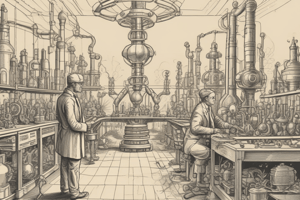Podcast
Questions and Answers
What factor affects SN2 reaction by reducing nucleophilicity through strong hydrogen bonding interactions?
What factor affects SN2 reaction by reducing nucleophilicity through strong hydrogen bonding interactions?
- Solvent type (correct)
- Steric effect
- Nucleophile strength
- Leaving group
What is the order of bond making and bond breaking in the SN1 mechanism?
What is the order of bond making and bond breaking in the SN1 mechanism?
- Two steps with carbocation intermediate (correct)
- One step with intermediate
- Two steps without intermediate
- One step without intermediate
Which type of solvent is typically used for efficient SN2 reactions?
Which type of solvent is typically used for efficient SN2 reactions?
- Non-polar solvents
- Polar aprotic solvents (correct)
- Saturated solvents
- Protic solvents with acidic protons
What type of nucleophiles are typically stronger according to the text?
What type of nucleophiles are typically stronger according to the text?
In which type of compounds does the SN1 mechanism occur?
In which type of compounds does the SN1 mechanism occur?
In nucleophilic substitution reactions, which component is necessary?
In nucleophilic substitution reactions, which component is necessary?
Which characteristic makes a leaving group better able to accept an electron pair?
Which characteristic makes a leaving group better able to accept an electron pair?
What characteristic do nucleophiles and bases share?
What characteristic do nucleophiles and bases share?
How are alkyl halides classified according to the number of carbon groups directly bonded to the carbon bearing the halogen atom?
How are alkyl halides classified according to the number of carbon groups directly bonded to the carbon bearing the halogen atom?
What role does the nucleophile play in nucleophilic substitution reactions?
What role does the nucleophile play in nucleophilic substitution reactions?
Flashcards are hidden until you start studying
Study Notes
Nucleophilicity
- Protic solvents can reduce nucleophilicity by interacting with nucleophiles via strong hydrogen bonds.
SN1 Mechanism
- Bond breaking precedes bond formation.
SN2 Reactions
- Polar aprotic solvents are best for SN2 reactions.
Nucleophile Strength
- Anionic nucleophiles are usually stronger than neutral nucleophiles.
SN1 Mechanism
- Tertiary alkyl halides favor the SN1 mechanism.
Nucleophilic Substitution Reactions
- A nucleophile is essential for nucleophilic substitution reactions; it attacks the electrophilic carbon in the substrate.
Leaving Groups
- Good leaving groups readily accept a pair of electrons.
Nucleophiles and Bases
- Nucleophiles and bases share the ability to donate an electron pair.
Alkyl Halides
- Alkyl halides are classified as primary, secondary, and tertiary based on the number of carbon groups attached to the carbon bearing the halogen.
Nucleophile Role
- Nucleophile substitutes the leaving group in nucleophilic substitution reactions.
Studying That Suits You
Use AI to generate personalized quizzes and flashcards to suit your learning preferences.




